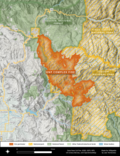Top Qs
Timeline
Chat
Perspective
2021 California wildfires
From Wikipedia, the free encyclopedia
Remove ads
By the end of 2021, a total of 7,396 wildfires burned 2,569,386 acres (1,039,794 ha) across the U.S. state of California.[2] Approximately 3,629 structures were damaged or destroyed by the wildfires, and three firefighters died during the wildfire season.[3]
The wildfire season in California experienced an unusually early start amid an ongoing drought and historically low rainfall and reservoir levels.[4] In January 2021 alone, 297 fires burned 1,171 acres (4.74 km2) on nonfederal land according to the California Department of Forestry and Fire Protection, which is almost triple the number of fires and more than 20 times the acreage of the five-year average for January.[5][4] The January fires were exacerbated by unseasonably strong Santa Ana winds, and some of them burned in the same areas as previous fires like the CZU Lightning Complex.[6]
The long term trend is that wildfires in the state are increasing due to climate change in California.[7][8] The 2021 wildfire season was exceptionally severe in California, although it did not approach the extent of the previous year's wildfire season, which was the largest season in the state's recorded history. As of July 11, more than three times as many acres have burned compared to the previous year through that date, with drought, extreme heat, and reduced snowpack contributing to the severity of the fires.[9][10][11] The state also faces an increased risk of post-wildfire landslides.[12][13]
As of August 18, 2021, the state of California was facing "unprecedented fire conditions" as multiple fires including the Dixie Fire, McFarland Fire, Caldor Fire, and others, raged on.[14] The USDA Forest Service temporarily closed all of California's national forests at the end of August to mitigate the impact of potential fires.[15]
On October 18, 2021, much of the state—particularly Northern California, where the majority of the significant fires had been located—received its first major precipitation since the start of the wildfire season.[16] This significantly lowered wildfire risk in the region.
Remove ads
Background
The timing of "fire season" in California is variable, depending on the amount of prior winter and spring precipitation, the frequency and severity of weather such as heat waves and wind events, and moisture content in vegetation. Northern California typically sees wildfire activity between late spring and early fall, peaking in the summer with hotter and drier conditions. Occasional cold frontal passages can bring wind and lightning. The timing of fire season in Southern California is similar, peaking between late spring and fall. The severity and duration of peak activity in either part of the state is modulated in part by weather events: downslope/offshore wind events can lead to critical fire weather, while onshore flow and Pacific weather systems can bring conditions that hamper wildfire growth.[17][18]
Remove ads
Impact
Summarize
Perspective
This section needs to be updated. (July 2021) |



PG&E and other utility companies preemptively spent billions of dollars to reduce the risk of wildfires and avoid an year similar to the previous year's fire season.[6][19] Firefighters have also set prescribed fires to prevent other fires burning.[20][21][22][23] During evacuations from the Lava Fire, an illegal marijuana farmer was shot and killed by police after brandishing a firearm at authorities, while "defending his farm".[24][25]
A 2023 study found that these wildfires are affecting the California ecosystem and disrupting the habitats.[26][27] It found that in the 2020 and 2021 fire seasons 58% of the area affected by wildfires occurred in those two seasons since 2012.[26][28] These two fires destroyed 30% of the habitat of 50 species as well as 100 species that had 10% of their habitats burn. 5-14% of the species' habitats burned at a "high severity."[26][29]
Remove ads
List of wildfires
Summarize
Perspective

The following is a list of fires that burned more than 1,000 acres (400 ha), or produced significant structural damage or casualties.
Remove ads
Wildfires listed by month
Gallery of maps
- Maps of significant wildfires in 2021 in California
See also
Notes
- Containment means that fire crews have established and secured control lines around the fire's perimeter. These lines are artificial barriers, like trenches or cleared vegetation, designed to stop the fire's spread, or natural barriers like rivers. Containment reflects progress in managing the fire but does not necessarily mean the fire is starved of fuel, under control, or put out.[30]
References
External links
Wikiwand - on
Seamless Wikipedia browsing. On steroids.
Remove ads









